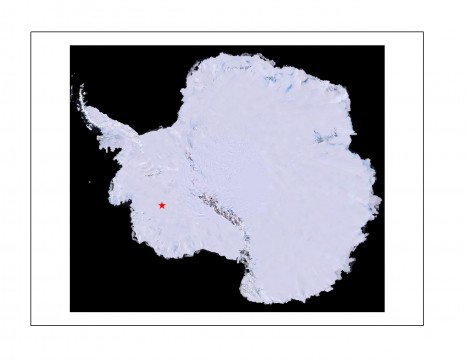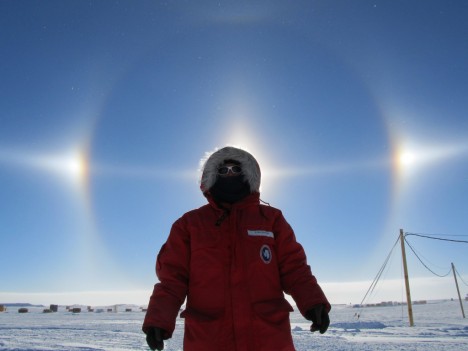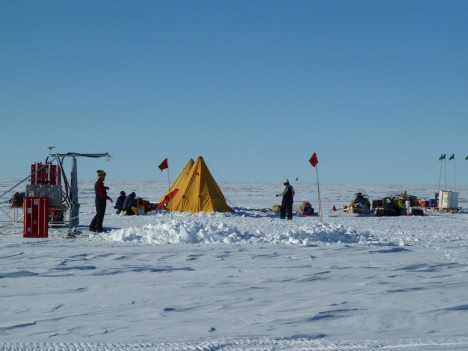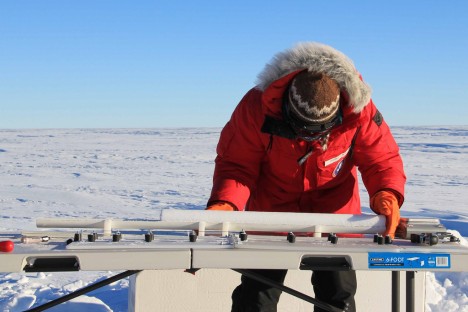By Lora Koenig
Hello! My name is Lora Koenig and I would like to welcome you to our Satellite Era Accumulation Traverse blog. I know that is a mouthful so we will call it the SEAT blog. So have a SEAT, grab a hot drink, and enjoy the blog. From now until mid-January, my colleagues and I will tell you about our science and adventures, from preparing our gear in the U.S. to riding snowmobiles across West Antarctica in order to study how much snow falls in Antarctica. You will hear about our team’s journey to Antarctica, the science we are doing and share in the fun we have while conducting field work in the coldest, driest, remotest and, forgive the pun, coolest continent on Earth. We are headed to the West Antarctica Ice Sheet, to a place called Byrd Station.

I suppose I should start with a short background of why exactly we are headed off to Antarctica and what we plan on doing there. But first a question: Have you ever wondered how we measure snow fall in Antarctica? It is actually rather difficult because, quite frankly, there are not a lot of people around with rulers. In the interior of the ice sheet, where we are headed, the snow falls each year and creates layers like a stack of pancakes — one pancake per year. The best way to measure snowfall, or accumulation, is by using ice cores that drill into the snow. Think of taking a straw and sticking it into your stack of pancakes and then measuring the thickness of each pancake. During this project we will be taking ice cores as well as using radars, that image the snow layers between the ice cores to measure accumulation rate, how much snow fell each year, over the past 30 years, the satellite era. It is our goal to use the data we get from our field-work to be able to better measure accumulation directly from satellites in the future.

That was a short introduction to the science. We will give you many more details as this blog develops between now and the end of the traverse in January 2011. For now I want to introduce you to the team. This project is funded by the National Science Foundation and NASA so we have team members from both NASA Goddard Space Flight Center and universities. The team members this season include: Jessica Williams, Randy Skinner and Summer Rupper from Brigham Young University; Clément Miège and Rick Forster from the University of Utah; Michelle Koutnik from the University of Copenhagen; and Ludovic Brucker and me, from Goddard Space Flight Center. In the next post, we will tell you about testing the ice core drill in Canada and preparing the radars for their trip to Antarctica. But first, meet the team:
Hi, my name is Jessica Williams and I just started my master’s degree at Brigham Young University in the Department of Geological Sciences. I am currently working with Dr. Summer Rupper looking at the snow and ice records from the surface of Antarctica. I am excited to go to Antarctica to drill some ice cores to take back to the lab at BYU to study. Using a combination of density, electrical conductivity, and isotope records from the ice cores we will be able to get snow accumulation rates in West Antarctica. In preparation for this trip I went to Switzerland and Canada to practice using the drill and to gain experience living on the ice.
My name is Randy Skinner and I am a geology professor at Brigham Young University in Provo, Utah. On an annual basis I instruct nearly 1,000 students, most in basic geology 101 classes. In Antarctica I will be involved in helping to obtain ice cores and digging snow pits. The ice cores will penetrate down to a depth of 20 meters. We will drill 10 of these cores while making our traverse of several hundred kilometers in western Antarctica. The cores and information from the snow pits will be used to determine rates of snow accumulation. I am very excited to be a part of this research, and to bring these experiences back to share with my future students.
Hi! I am Summer Rupper, and I am a professor in the geology department at Brigham Young University, Utah. My research is largely focused on the interplay between glaciers and climate. In particular for our work in Antarctica, my students and I are using the physical and chemical properties of ice to reconstruct the past 30-40 years of temperature and snow accumulation rates. I was in Antarctica last year helping our team drill ice cores for this research. This year, I, along with my students, will be continuing the processing of those ice cores in our freezer lab at Brigham Young, while the rest of the team heads back to Antarctica to collect more cores. I am very excited to have such a great team going to Antarctica again this year, and can’t wait to hear all about their adventures upon their safe return.

My name is Michelle Koutnik and I work at the Center for Ice and Climate at the University of Copenhagen in Denmark. I grew up in Southern California, but now I enjoy living in Northern Europe. I was in Antarctica last season as part of this project and I look forward to a second traverse across Central West Antarctica. I use computer models of ice-sheet flow to understand ice-sheet evolution over tens of thousands of years. This project is different because we focus on ice-sheet evolution over tens of years. I have been working on a computer model focused in the region of Antarctica that we will be doing field work — I am excited for a real trip there instead of just a virtual one! It will be great to face the challenges of the Antarctic environment and also to work with this team to accomplish our goals.
I am Clément Miège, a PhD student in the Department of Geography at the University of Utah. I am originally from France and I am currently working with Dr. Richard Forster on Greenland and Antarctic snow accumulation patterns. This year will be my second Antarctic field season. During this traverse, I will operate 2 high-frequency radars, in order to produce images of internal snow/firn layers. Later, those images will be used, with the help of ice cores, to give us snow accumulation rates. So we will be able to understand 30-40 years of history for this part of the ice sheet. I am very excited to be on this traverse to keep exploring Antarctica and share this extraordinary experience!!

Hi there! I’m Ludovic Brucker, one of the French citizens on the team. I came to the US in early 2010 after defending my PhD on passive microwave remote sensing of Antarctic snow. I’m currently a scientist at NASA Goddard Earth Sciences Technology and Research (GESTAR) Studies and Investigations, Universities Space Research Association (USRA), Greenbelt, MD. This season sounds incredibly exciting and I look forward to our deployment on the West Antarctic Ice Sheet to conduct a 400 miles (~650 km) scientific traverse with snow mobiles! After three years studying the evolution of Antarctic snow properties through the use of satellite observations, I’ll now have a chance to see how the snow really looks! I can’t wait to be on the ice and see how correct, or not, my ideas of Antarctica are!
My name is Lora Koenig and I am a physical scientist in the Cryospheric Sciences Branch at NASA’s Goddard Space Flight Center. I am a remote-sensing glaciologist who uses satellites to monitor the ice sheets and I am always interested in how well measurements from space compare to those taken on the ground. My interest in ground truth data and learning more about ice sheets will take me to Antarctica for a third time this season. I have always loved snow and ice. I started skiing in the Pacific Northwest before I started school and my love for being in cold outdoor places continued into graduate school where I studied topics dealing with both seasonal snow and the polar ice sheets. My expertise is in microwave remote sensing of the ice sheets.
Tags: Antarctica, ice, NASA, snow, traverse




Hi! Cool project.
I just made a bet with father, if is there the total amount of new snow (precitipation) per year higher or smaller than 4 cm. What do you think ??? Zeb
I would like to obtain use of the photo of Michelle Koutnik for use in my glacier chapter in college textbook, Geology and the Environment. It may be in the public domain, but it may not. Please advise about ordering and permission.
D. Trent
Claremont, CA
D. Trent: I am helping Dr. Koenig post and adminster this blog; I will check with her and get back to you. (Glad you like the pic!) — Patrick Lynch
Dear, D. Trent,
Dr. Koenig said the photo is of course in the public domain. You can find it here. Please be sure to include the proper crediting. Thanks! — Patrick Lynch
Sounds very interesting!
I find it amazing that people go to stay in such cold climes.
Trust your findings will be helpful in the broader context of climate change.
WFS
As a former USAP employee and geologist, I look forward to reading of your travels and discoveries. Keep warm and NEVER take Antarctica for granted.
Awesome! I’d love to read just what it’s like to BE in Antarctica, and what daily life is like there.
And if those coats do a good job of keeping the cold out…
Stay warm. 😀
Clinton,
The red coats which we call “Big Red” not only keep us warm but have great pockets to keep our batteries, chocolate bars and water bottles unfrozen.
Lora
good
good i love antartica soon i’ll be there 🙂
The image of Lora Koenig with parhelia behind her is quite stunning. Besides the obvious “sun-dogs”, it also clearly shows the 22° halo (circle), the parheliac arc (the curved line running through the sun and both parhelia), and a very faint upper tangent arc. It must be an amazing experience to witness such spectacular natural phenomena.
Peter,
I love seeing Halos and sun dogs. In case you are interested in the physics behind it there was a nice article writing about them in the UBC alumni newsletter. Check out page 6 at this link http://www.eos.ubc.ca/home/alumni/2011-Alumni%20Newsletter.pdf
Lora
Wow, the pictures are awesome! I wish I could go to Antarctica, it’s the most fascinating place on earth IMO!
Must be cold out here but I would still like to visit the ice deserts sometimes 🙂